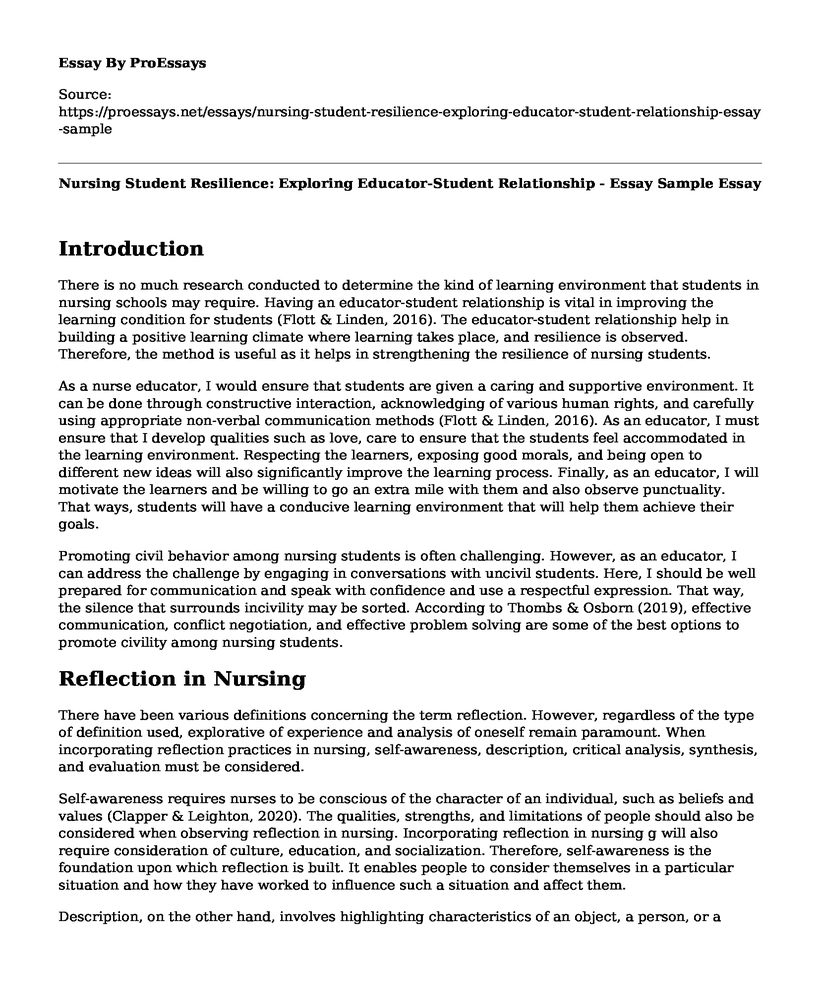Introduction
There is no much research conducted to determine the kind of learning environment that students in nursing schools may require. Having an educator-student relationship is vital in improving the learning condition for students (Flott & Linden, 2016). The educator-student relationship help in building a positive learning climate where learning takes place, and resilience is observed. Therefore, the method is useful as it helps in strengthening the resilience of nursing students.
As a nurse educator, I would ensure that students are given a caring and supportive environment. It can be done through constructive interaction, acknowledging of various human rights, and carefully using appropriate non-verbal communication methods (Flott & Linden, 2016). As an educator, I must ensure that I develop qualities such as love, care to ensure that the students feel accommodated in the learning environment. Respecting the learners, exposing good morals, and being open to different new ideas will also significantly improve the learning process. Finally, as an educator, I will motivate the learners and be willing to go an extra mile with them and also observe punctuality. That ways, students will have a conducive learning environment that will help them achieve their goals.
Promoting civil behavior among nursing students is often challenging. However, as an educator, I can address the challenge by engaging in conversations with uncivil students. Here, I should be well prepared for communication and speak with confidence and use a respectful expression. That way, the silence that surrounds incivility may be sorted. According to Thombs & Osborn (2019), effective communication, conflict negotiation, and effective problem solving are some of the best options to promote civility among nursing students.
Reflection in Nursing
There have been various definitions concerning the term reflection. However, regardless of the type of definition used, explorative of experience and analysis of oneself remain paramount. When incorporating reflection practices in nursing, self-awareness, description, critical analysis, synthesis, and evaluation must be considered.
Self-awareness requires nurses to be conscious of the character of an individual, such as beliefs and values (Clapper & Leighton, 2020). The qualities, strengths, and limitations of people should also be considered when observing reflection in nursing. Incorporating reflection in nursing g will also require consideration of culture, education, and socialization. Therefore, self-awareness is the foundation upon which reflection is built. It enables people to consider themselves in a particular situation and how they have worked to influence such a situation and affect them.
Description, on the other hand, involves highlighting characteristics of an object, a person, or a situation without giving out judgment (Banerjee & John, 2020). A description is effective in reflection-on-action as it provides a comprehensive account of a situation. It enables those who were not there to understand the situation from your viewpoint.
Another essential component of reflection in nursing is critical analysis. It helps in separating a situation into various components (Banerjee & John, 2020). Therefore, acknowledging and analyzing believes, values, and cultures of people are integral elements of reflection. Thus, reflection cannot be successful without critical analysis. Synthesis, on the other hand, is vital in reflection practices as it allow for the integration of new concepts, feeling, or attitude with previous knowledge, feeling, and attitude. That is essential as it creates a new insight or perspective of a situation.
Generally, reflection is essential in nursing as it helps in promoting patient care. It helps relating and comparing the situation to come up with informed judgment. Therefore, reflection should be incorporated in nursing to help improve effective health care.
References
Banerjee, S., & John, P. (2020). Nudge plus: incorporating reflection into behavioural public policy. https://jmvh.org/wp-content/uploads/2018/08/Incorporating-Reflective-Practice.pdf
Clapper, T. C., & Leighton, K. (2020). Incorporating the Reflective Pause in Simulation: A Practical Guide. The Journal of Continuing Education in Nursing, 51(1), 32-38. https://www.researchgate.net/publication/314550489_The_Need_To_Incorporate_Reflective_Practice_Into_Nursing_Education_Curriculum_In_Nigeria
Flott, E. A., & Linden, L. (2016). The clinical learning environment in nursing education: a concept analysis. Journal of Advanced Nursing, 72(3), 501-513. https://www.researchgate.net/publication/286445135_The_clinical_learning_environment_in_nursing_education_A_concept_analysis
Thombs, D. L., & Osborn, C. J. (2019). Introduction to addictive behaviors. Guilford Publications. https://www.researchgate.net/publication/302941121_Conversations_to_inspire_and_promote_a_more_civil_workplace_Let's_end_the_silence_that_surrounds_incivility
Cite this page
Nursing Student Resilience: Exploring Educator-Student Relationship - Essay Sample. (2023, Apr 24). Retrieved from https://proessays.net/essays/nursing-student-resilience-exploring-educator-student-relationship-essay-sample
If you are the original author of this essay and no longer wish to have it published on the ProEssays website, please click below to request its removal:
- Individual Critical Reflection Paper on a Pregnant Woman
- Planning and Budgeting in Pharmacy Services - Paper Example
- Improving Community Health Through Social Change: Annotated Bibliography
- Essay Sample on Energy Drinks: Benefits, Risks and Alternatives
- Essay Sample on Data-Driven Population Wellbeing: A Comprehensive Look
- Reporting Incidents Improve Patient Safety: Administer Penicillin G Benzathine IV With Care - Essay Sample
- Paper Example on Designing Facilities for Optimal Healthcare: Stakeholder Perspectives







